Categories
Archives

The IPTC Photo Metadata Working Group has released version 2025.1 of the IPTC Photo Metadata Standard, including properties that can be used for AI-generated content.
The new properties are:
- AI System Used
Definition: The AI engine and/or the model name used to generate this image.
User Note: For example, ChatGPT DALL-E, Google Gemini, ChatGPT
Suggest help text: Enter the name of the AI system and/or the model name used to generate this image. - AI System Version Used
Definition: The version of the AI system used to generate this image, if known.
Suggested help text: Enter the name or number of the version of the AI system used to generate this image. - AI Prompt Information
Definition: The information that was given to the generative AI service as “prompt(s)” in order to generate this image.
User Note: This may include negative [excludes] and positive [includes] statements in the prompt.
Suggested help text: Enter the information given to the generative AI service as “prompt(s)” in order to generate this image. - AI Prompt Writer Name
Definition: Name of the person who wrote the prompt used for generating this image.
User Note: This person should not be considered as the image creator.
Suggested help text: Enter the name of the person who wrote the prompt used for generating this image.
IPTC’s specification materials have been updated to accommodate the new properties:
- IPTC Photo Metadata Standard Specification 2025.1
- The IPTC Photo Metadata User Guide has been updated, particularly the guidance on Applying Metadata to AI-generated images
- The IPTC Photo Metadata Reference Image 2025.1 which contains values for all IPTC Photo Metadata properties, including the four properties added in version 2025.1
- IPTC Photo Metadata TechReference:
- The GetPMD photo metadata reading tool has been updated to read the new fields.
The new properties are expected to be implemented in software tools soon. The popular open-source tool Exiftool already supports the new properties, since version 13.40 which was released on October 24th 2025.
Thanks to everyone who contributed to our request for comments on these new properties. We made several changes based on feedback from IPTC members and others, so your contributions were well appreciated.
For more information please contact IPTC or join our public iptc-photometadata@groups.io mailing list.
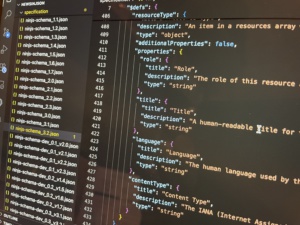
The IPTC News in JSON Working Group today released the latest in each version of the ninjs: 3.2, 2.3 and 1.7.
ninjs is IPTC’s standard for storage and distribution of news in JSON format. Using JSON means that ninjs works well for fast and simple exchange of news content for APIs, search engine platforms such as Elasticsearch and AWS OpenSearch, and for lightweight storage in databases, CMSs and cloud storage. It can be used to distribute news content in any format such as text, audio, video or images; can handle event and news coverage planning, rich metadata descriptions including relevant people, places, subjects and events; and can include packages of related news content via an associations mechanism.
The IPTC News in JSON Working Group maintains three parallel versions of ninjs so that those who implement the 1.x, 2.x or 3.x branch can all receive the latest additions in a backwards-compatible manner.
The changes adopt a new structure within the renditions array. Each rendition can now have resources associated, which allows a ninjs feed to express multiple channels or tracks within a media stream. For example, a live video stream from the EU Parliament may include several different audio tracks featuring live translations in different spoken languages; a subtitle track in WebVTT or TTML format, audio description tracks and more.
The changes have been added to all three versions of ninjs in accordance with the conventions of each version.
- https://www.iptc.org/std/ninjs/ninjs-schema_3.2.json
- https://www.iptc.org/std/ninjs/ninjs-schema_2.3.json
- https://www.iptc.org/std/ninjs/ninjs-schema_1.7.json
The ninjs User Guide, ninjs Generator tool has also been updated for the new version.
For any comments or suggestions for new properties that we should add to future versions of ninjs,

The IPTC Video Metadata Working Group is happy to announce that version 1.7 of its flagship standard, Video Metadata Hub, has now been released.
The new version has four new properties which allow users and tools to embed metadata about AI prompt information that was used to generate the image, if applicable.
The new properties in detail are:
- AI System Used (text string, single-valued, optional)
The AI engine and/or the model name used to generate this media.
Note: For example, ChatGPT DALL-E, Google Gemini, ChatGPT - AI System Version Used (text string, single-valued, optional)
The version of the AI system used to generate this media, if known. - AI Prompt Information (text string, single-valued, optional)
The information that was given to the generative AI service as “prompt(s)” in order to generate this media.
Note: This may include negative [excludes] and positive [includes] statements in the prompt. - AI Prompt Writer Name (text string, single-valued, optional)
Name of the person who wrote the prompt used for generating this media.
Note: this person should not be considered as the media creator.
Please note that users should not expect that the contents of the “AI Prompt Information” property could be given directly to an AI system to generate the same video; there are many reasons why generated media files differ even for the same input information. The Working Group decided to add “AI Prompt Information” as a generic property that creators could use to describe the process that was used to prompt an AI system to create the content.
The official IPTC Video Metadata Hub recommendation files and user documentation have all been updated for the new version:
- IPTC Video Metadata Hub 1.7 properties table
- IPTC Video Metadata Hub 1.7 full mappings table
- IPTC Video Metadata Hub 1.7 user guide
- IPTC Video Metadata Hub generator – A tool that can help developers to understand how Video Metadata Hub works and to generate example files
- IPTC Video Metadata Hub 1.7 JSON Schema
The Video Metadata Working Group welcomes feedback. Please post to the IPTC Video Metadata public discussion group or use the IPTC Contact Us form.
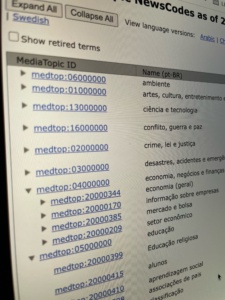
The NewsCodes Working Group is pleased to release the Q3 2025 update to our NewsCodes vocabularies.
MediaTopics updates
As usual most of the updates are to the Media Topic vocabulary.
New concepts (3)
Retired concepts (1)
- water –
Label changes (3)
- hazardous materials -> hazardous material
- waste materials -> waste material
- pests -> pest and pest control
Definition changes (16)
- environment
- environmental pollution
- air pollution
- environmental clean-up
- hazardous material
- water pollution
- nature
- ecosystem
- endangered species
- invasive species
- animal disease
- plant disease
- animal
- flowers and plants
- pest and pest control
- sustainability
Modified notes (2)
animal disease,
pest and pest control
No concepts were retired, had hierarchy moves or modified wikidata mappings this time.
Translation updates
Many terms and definitions in the German translation were updated to reflect recent changes in the English versions.
Norwegian and Swedish terms were updated to reflect recent changes in the English versions.
2025-Q2 updates recap
It seems that we didn’t post a news item about the 2025-Q2 changes to Media Topics. Here’s a summary:
- New term vegetarianism and veganism
- climate change – definition changed
- global warming retired. Use climate change instead.
- conservation – definition changed
- energy saving – retired. Use medtop:20001374 sustainability instead.
- parks -> nature preserve
- New Term: park and playground (Child of leisure venue medtop:20000553)
- natural resources -> natural resource
- energy resources retired. Use the relevant term from the business branch instead.
- land resources retired.
- forests -> forest. Moved to be child of nature.
- mountains -> mountain. Moved to be child of nature.
- population growth – retired. Use “population and census” instead.
- oceans -> ocean. Moved to be child of nature.
- rivers -> river. Moved to be child of nature.
- wetlands -> wetland. Moved to be child of nature.
- mankind -> demographic group.
Trust Indicator updates
The Trust Indicator vocabulary had one hierarchy change: factCheckingPolicy was made a child of editorialPolicy.
Also, the notes on terms have been updated to give credit to The Trust Project for their work and to indicate that the term “Trust Indicators®” is now a registered trademark of The Trust Project.
Working with IPTC NewsCodes
See the official Media Topic vocabulary on the IPTC Controlled Vocabulary server, and an easier-to-navigate tree view. An Excel version of IPTC Media Topics is also available. Other NewsCodes are available via the CV Server .
See the IPTC NewsCodes Guidelines document for information on our vocabularies and how you can use them in your projects.
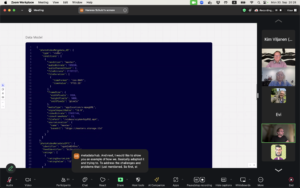
The IPTC Video Metadata Working Group has released version 1.6 of its Video Metadata Hub standard, including terms for rights usage, language, and content created by Generative AI models.
New properties
-
Rights Usage Terms: The licensing parameters of the video expressed in free text. (Aligned with the equivalent term in IPTC Photo Metadata.)
Changed properties
-
Language: Changed label and description to reflect that this represents the main language of the video. (Previously the term was called “language version”).
-
Source (Supply Chain): Changed description to reflect that changes made be made by a system (such as a Generative AI engine) as well as a person or organisation.
The specification for Video Metadata Hub is separated into two parts: IPTC Video Metadata Hub properties and IPTC Video Metadata Hub mappings showing how to apply these core properties in many existing video standards.
There is also a JSON Schema representation of Video Metadata Hub, which is used by some large media companies in manageing their video content. The 1.6 version of the JSON schema reflects the latest changes.
The Video Metadata Hub User Guide and Video Metadata Hub Generator tool have also been updated to include the changes in version 1.6.
Please feel free to discuss the new version of Video Metadata Hub on the public iptc-videometadata discussion group, or contact IPTC via the Contact us form.
The latest version of NewsML-G2, version 2.35 has been released, adding support for the status of events.
Approved by the IPTC Standards Committee at the IPTC Spring Meeting, on 16th May, the new version adds a property eventStatus which matches the equivalent property in ninjs that was added in version 3.0.
eventStatus, within the eventDetails block, describes the status of an actual event – as opposed to occurenceStatus, which conveys the status of how likely it is that a future event will occur, and coverageStatus, which conveys the planned news coverage of a news event.
The recommended controlled vocabulary for eventStatus is http://cv.iptc.org/newscodes/eventstatus, which currently contains the terms “scheduled“, “in progress“, “completed“, “postponed” and “canceled“.
IPTC Catalog updated to version 41
The IPTC Catalog, the master list of internally- and externally-managed controlled vocabularies used and referenced by NewsML-G2, has been updated to version 41. It adds the PLUS Licence Data Format vocabulary, used extensively in IPTC Photo Metadata and now in other standards through the introduction of the Data Mining vocabulary.
The latest catalog is available at http://iptc.org/std/catalog/catalog.IPTC-G2-Standards_41.xml (note the plain http URL scheme. We don’t link directly to it here because clicking the link may trigger browser warnings about moving from https to http URLs.)
Find out more about NewsML-G2 2.35
All information related to NewsML-G2 2.35 is at https://iptc.org/std/NewsML-G2/2.35/.
The NewsML-G2 Specification document has been updated to cover the new version 2.35.
Example instance documents are at https://iptc.org/std/NewsML-G2/2.35/examples/.
Full XML Schema documentation is located at https://iptc.org/std/NewsML-G2/2.35/specification/XML-Schema-Doc-Power/
XML source documents and unit tests are hosted in the public NewsML-G2 GitHub repository.
The NewsML-G2 Generator tool has also been updated to produce NewsML-G2 2.35 files using the version 41 catalog.
For any questions or comments, please contact us via the IPTC Contact Us form or post to the iptc-newsml-g2@groups.io mailing list. IPTC members can ask questions at the weekly IPTC News Architecture Working Group meetings.
For more information, contact the IPTC News Architecture Working Group via the public NewsML-G2 mailing list.
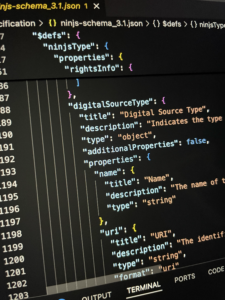
The IPTC is excited to announce the latest updates to ninjs, our JSON-based standard for representing news content metadata. Version 3.1 is now available, along with updated versions 2.2 and 1.6 for those using earlier schemas.
These releases reflect IPTC’s ongoing commitment to supporting structured, machine-readable news content across a variety of technical and editorial workflows.
What is ninjs?
ninjs (News in JSON) is a flexible, developer-friendly format for describing news items in a structured way. It allows publishers, aggregators, and news tech providers to encode rich metadata about articles, images, videos, and more, using a clean JSON format that fits naturally into modern content pipelines.
What’s new in ninjs 3.1, 2.2 and 1.6?
The new releases add a new property for the IPTC Digital Source Type property, which was first used with the IPTC Photo Metadata Standard but now used across the industry to declare the source of media content, including content generated or manipulated by a Generative AI engine.
The new property (called digitalSourceType in 3.1 and digitalsourcetype in 2.2 and 1.6 to match the case conventions of each standard version) has the following properties:
- Name: the name of the digital source type, such as “Created using Generative AI”
- URI: the official identifier of the digital source type from the IPTC Digital Source Type vocabulary or another vocabulary, such as http://cv.iptc.org/newscodes/digitalsourcetype/trainedAlgorithmicMedia (the official ID for generative AI content)
- Literal: an optional way to add new digital source types that are not part of a controlled vocabulary.
IPTC supports multiple versions of ninjs in parallel to ensure stability and continuity for publishers and platforms that depend on long-term schema support.
The new property is part of the general ninjs schema, and so can be used in the main body of a ninjs object to describe the main news item and can also be used in an “association” object which refers to an associated media item.
Access the schemas
All versions are publicly available on the IPTC website:
ninjs generator and user guide
The ninjs Generator tool has been updated to cover the latest versions. Fill in the form fields and see what that content looks like in ninjs format. You can switch between the schema versions to see how the schema changes between 1.6, 2.2 and 3.1.
The ninjs User Guide has also been updated to reflect the newly added property.
Why it matters
As the news industry becomes increasingly reliant on metadata for content distribution, discoverability, and rights management, ninjs provides a modern, extensible foundation that supports both human and machine workflows. It’s trusted by major news agencies, technology platforms, and AI developers alike.
Get involved
We welcome feedback from the community and encourage you to share how you’re using ninjs in your own products or platforms. If you would like to discuss ninjs, you can join the public mailing list at https://groups.io/g/iptc-ninjs.
If you’re interested in contributing to the development of IPTC standards, join us!

The IPTC NewsCodes Working Group is pleased to present the Q1 2025 release of IPTC NewsCodes.
As usual, most of the updates are in our flagship subject vocabulary, Media Topics.
Media Topic updates
This release adds 8 new concepts, retires 17 concepts, modifies 43 label names and 64 definitions, adds 10 notes (mostly to retired concepts), makes 28 hierarchy moves and modifies 7 wikidata mappings.
The new and modified terms have already been translated into Swedish (lang=se) and Norwegian (lang=no-NB and lang=no-NN)
New concepts (8 terms)
zoning policy, political party, political movement and association, communism, democratic socialism, theocracy, absolute monarchy, ski mountaineering
Note that ski mountaineering (medtop:20001390) has been added to the Media Topics vocabulary because it was added as a new sport for the 2026 Olympics.
Retired concepts (17 terms)
- civil and public service – use government employee (medtop:20000595) instead.
- military equipment – use military weaponry and equipment (medtop:20000602) instead.
- security measures (defence) – use national security (medtop:20000598) instead.
- national security (old) – Use national security (medtop:20000598) instead.
- public finance – Use government budget (medtop:20000607) or government debt (medtop:20000368) instead.
- government department – Use more specific terms or government (medtop:20000593) instead.
- safety of citizens – Use other terms such as public health (medtop:20001358) or emergency response (medtop:20000168) instead.
- interior policy – Use more specific terms instead.
- personal data collection policy – Use data protection policy (medtop:20000627) instead.
- planning inquiries – Use zoning policy (medtop:20001383), environmental policy (medtop:20000423) or other more specific terms instead.
- political crisis – Use more specific terms instead.
- political process – Use government (medtop:20000593) or other more specific terms instead.
- political parties and movements – Use political party (medtop:20001384) or political movement and association (medtop:20001385) instead.
- political development – Use politics (medtop:11000000) instead.
- civilian service – Use medtop:20001277 volunteering instead.
- integration policy – Use immigration policy (medtop:20000634) instead.
- regulatory authority – Use regulation of industry (medtop:20000636) instead.
Modified labels (43 terms)
politics and government, demonstration, government employee, public officials, constitution (law).
national security.military weaponry and equipment, head of state,local authority, minister or secretary (government), regional authority, taxation policy, data protection policy, immigration policy, summit meeting, treaty, foreign aid, international organisation, refugees and internally displaced people, non-governmental organisation (NGO), political prisoners and dissenters, cultural policy, sports policies, political party convention, political committee, head of government, border dispute, financial service, corporate bond, war victims, missing in action, breaking (breakdance), by-election, recall election, coalition building, zoning policy, political party, political movement and association, communism, democratic socialism, theocracy, absolute monarchy, ski mountaineering.
Modified definitions (64 terms)
politics and government, demonstration, computer networking, economic policy, environmental policy, healthcare policy, government, government employee, public officials, constitution (law), national security, armed forces, military weaponry and equipment, executive (government), government budget, head of state, local authority, minister or secretary (government), regional authority, taxation policy, government policy, nationalisation, privatisation, state-owned enterprise, data protection policy, policy towards indigenous people, pension and welfare policy, personal weapon control policy, immigration policy, nuclear policy, regulation of industry, food and drink regulations, international relations, diplomacy, summit meeting, treaty, economic sanction, foreign aid, international organisation, refugees and internally displaced people, non-governmental organisation (NGO), political prisoners and dissenters, lobbying, political system, democracy, dictatorship, cultural policy, sports policies, regional development policy, political party convention, head of government, infrastructure policy, economic development incentive, political leadership, border dispute, education policy, zoning policy, political party, political movement and association, communism, democratic socialism, theocracy, absolute monarchy, ski mountaineering.
Modified notes (10 terms)
safety of citizens, interior policy, personal data collection policy, planning inquiries, political crisis, political process, political parties and movements, political development, civilian service, integration policy.
Modified broader terms (hierarchy moves) (28 terms)
campaign finance, government employee, public officials, military weaponry and equipment, espionage and intelligence, data protection policy, housing and urban planning policy, policy towards indigenous people, pension and welfare policy, personal data collection policy, personal weapon control policy, planning inquiries, lobbying, political parties and movements, political development, political system, integration policy, regional development policy, infrastructure policy, political leadership, zoning policy, political party, political movement and association, communism, democratic socialism, theocracy, absolute monarchy, ski mountaineering.
Modified wikidata mappings: 7
political party, political movement and association, communism, democratic socialism, theocracy, absolute monarchy, ski mountaineering.
See the official Media Topic vocabulary on the IPTC Controlled Vocabulary server, and an easier-to-navigate tree view. An Excel version of IPTC Media Topics is also available.
Non-Media Topic changes
- New term: Software
- New terms: anonymised, recommended anonymisation
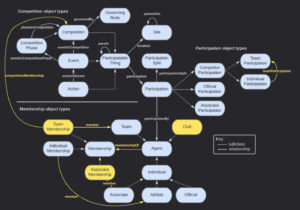
The IPTC Sports Content Working Group is proud to release version 1.1 of IPTC Sport Schema.
Documented at the dedicated site sportschema.org, Sport Schema is IPTC’s semantic web (RDF) based ontology for describing sports listings, results, statistics and even play-by-play actions during any kind of sports event.
Version 1.1 adds the following new features:
- We add a Club type, which can handle the organisation that hosts one or more teams of varying types, possibly across various sports. (Did you know that Bayern Munich has not just the famous men’s, women’s and junior football/soccer teams, but also basketball, handball, table tennis and even chess teams!)
- We also add a TeamMembership type, so a Team can be a member of a Club (and could theoretically move from one Club to another).
- We add support for the concept of “sports facets” that we originated in SportsML. (based on SportsML / NewsCodes facets) so we can now say that an event is “women’s 400 metres relay swimming”, not just “swimming”. The boxing example shows that the weight class of the event is “welterweight”.
- Added the ability to link from Athlete to Team via a new teamParticipation property.
- Add an AssociateMembership type so an Associate (such as a coach) can have a tenure relating to any Agent, including an Athlete or a Team. Previously Associates were linked to Teams via Participation objects which wasn’t satisfactory.
- Expanded and added to examples including a Boxing example showing how the new AssociateMembership type can be used to represent a coach or manager of an individual athlete (in this case a boxer)
- Added new golf ontology taking some properties from SportsML and some from the Golf vocabularies in IPTC NewsCodes. We have merged them together in Sport Schema for ease of use.
- Many cleanups to the SHACL Shapes used for validation of data.
Please take a look at Sport Schema and let us know what you think! We would love to hear about Sport Schema being implemented in real-world projects. Please contact IPTC using the Contact Us form or via the public discussion list at groups.io/g/iptc-sportsml/
At the IPTC Autumn Meeting, the IPTC Standards Committee voted on a change proposed by the Photo Metadata Working Group, which created version 2024.1 of the IPTC Photo Metadata Standard.
The change is minor but important to some: the definition of the Keywords property now includes the following text:
Keywords to express the subject and other aspects of the content of the image. Keywords may be free text and don’t have to be taken from a controlled vocabulary. Codes from the controlled vocabulary IPTC Subject NewsCodes must go to the “Subject Code” field.
This aligns the property definition with the way in which many photo agencies and photographers were already using the field: to convey aspects such as the lighting or lens effects used, “mood” of the image, dominant colour and more.
We give examples of how the Keywords property may be used in the IPTC Photo Metadata User Guide.
The relevant files have all been updated for the new version:
- The IPTC Photo Metadata Standard Specification
- The IPTC Photo Metadata User Guide
- The IPTC Photo Metadata TechReference, in both YAML and JSON formats
- The IPTC Photo Metadata Reference Image
We thank Agence France-Presse for their help in offering examples for how the Keywords property may be used.